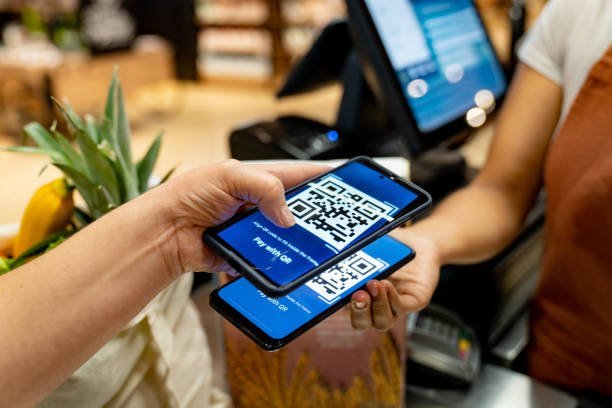QR Code
Quick Response Codes, or QR codes for short, are two-dimensional barcodes made up of white squares arranged in a black square grid. Numerous types of data, including text, URLs, contact details, and other types of information, can be stored in QR codes.
When a smartphone or other QR code reader device scans a QR code, it decodes the encoded data and performs the necessary action, like opening a webpage, displaying text, or adding contacts to the devices address book. Their adaptability, simplicity of use, and capacity to hold vast volumes of data in a small format have contributed to their rise in popularity.
The QR code was created in 1994 by Masahiro Hara and his team at Denso Wave, a subsidiary of the Toyota Group. It was originally designed to track automotive parts during manufacturing. However, due to its capability to store large amounts of data and quick readability, QR codes quickly became popular. Today, QR codes are widely used across various industries and applications worldwide.

Types of QR Code
There are generally two types of QR Code:
- Static QR Code
- Dynamic QR Code
Static QR Code:
A QR code that has fixed data and does not change over time is called a static QR code. Until the QR code is changed or recreated, the data encoded in a static QR code stays the same after it is created.
The following applications, where the data being encoded is constant, commonly use static QR codes:
- Contact details: preserving information such as addresses, phone numbers, email addresses, and names.
- Website URLs: Pointing visitors to particular online pages.
- Product information: Giving specifics about the product, like its specs or usage guidelines.
- Marketing materials: Such as advertisements, discounts, or exclusive deals.
Static QR codes are widely used for a variety of purposes and are simple to generate because the data they encode is always the same.
Dynamic QR Code
One kind of QR code that has a link to a web server where the encoded data is kept is called a dynamic QR code. In contrast to static QR codes, dynamic QR codes allow for data encoding that is updated or changed without requiring the QR code to be changed. More flexibility as well as real-time tracking and analytics are made possible by this.
When more functionality is needed or when the encoded data may need to be updated frequently, dynamic QR codes are frequently utilized. Among the benefits of dynamic QR codes are:
- Updateability: A new QR code does not need to be created in order to modify or update the encoded data. When you need to update event details, contact details, or product information, this is useful.
- Analytics and tracking: Among other metrics, it is possible to monitor the number and location of scans with dynamic QR codes. This can offer insightful information about user participation and the efficacy of campaigns.
- Enhanced functionality: By integrating dynamic QR codes with backend systems, adding features like user authentication, inventory management, and personalized content delivery.
- Security: Dynamic QR codes can incorporate security features like authentication or encryption to stop unauthorized access or tampering with the encoded data.
Numerous businesses provide dynamic QR code services; the majority charge based on usage or subscription. These services, which offer tools for creating, managing, and tracking dynamic QR codes, make it simple for businesses and individuals to benefit from the advantages of dynamic QR code technology.
Advantages of QR code
Compared to conventional means of data storage and information exchange, QR codes have a number of benefits. Among the principal benefits are:
- Simplexes of Use: Using a smartphone or QR code reader app, creating, sharing, and scanning QR codes is simple. This eliminates the need for specialized tools or technological know-how and makes them available to a broad spectrum of users.
- Rapid Data Transfer: Quick and effective information transfer is made possible by QR codes’ ability to store large amounts of data in a compact format. Sharing URLs, contact information, and other kinds of data that would be difficult to manually enter are particularly good uses for this.
- Flexibility: QR codes are versatile and can store different types of data, making them useful for various applications such as marketing, ticketing, inventory management, and authentication.
- Offline Accessibility: QR codes are perfect in situations where internet connectivity is either restricted or nonexistent because they can be scanned and accessed offline. QR codes, for instance, can be applied to printed items like business cards, posters, and product packaging.
- Enhanced Security: To prevent unauthorized access or tampering, QR codes can include security features like authentication or encryption. This contributes to protecting sensitive data’s confidentiality and integrity.
- Cost-Effectiveness: Creating and utilizing QR codes is frequently less expensive than more conventional data exchange techniques like printing hard copies of documents or sending out paper-based materials. Because QR codes are easy to create and distribute electronically, they save money on printing and distribution.
- Real-Time Analytics and Tracking: You can track a number of metrics in real-time with dynamic QR codes, such as the number of scans and where they are scanned. Businesses can improve the effectiveness of their marketing campaigns by learning insightful information about user engagement and campaign efficacy.
All things considered, QR codes provide a practical, effective, and adaptable way to share information and interact with users on a range of platforms and applications.



